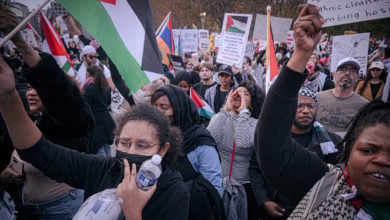We have been hearing repeatedly that the so-called surge in Iraq is over—now that 23,000 troops have left Iraq and the number of U.S. battalions there is back to pre-January 2007 levels.
|
The standard news story is that, thanks to the surge, U.S. and Iraqi casualties are down, “security” has improved and Iraq is on its way to a “free,” stable society in which the United States will play a progressively smaller role.
But how does this story compare with reality? Iraq has now been a country under siege and occupied for more than five years. The surge, which the BBC astutely called “the pacification process,” has been an extremely bloody affair.
The year of the surge had the highest number of U.S. soldier deaths, and the first six months of the surge were the deadliest for civilians since the beginning of the invasion.
Surge proponents frame the issue in terms of “death rates.” After repeating enough that deaths are down 10 or 20 percent, the public begins to forget about actual deaths.They serve to hide the devastating human toll of the war.
Here are the real numbers for Iraq: 466 violent civilian deaths in January, 633 in February, 968 in April, 505 in May and 448 in June. This last number, 448, we are supposed to celebrate as some great historic low, a sign of progress.
According to U.N. figures, the number of civilians killed in Afghanistan has risen by almost two-thirds in the first half of the year compared with 2007. A total of 698 civilians have been killed, including more than a dozen civilians recently killed at a wedding ceremony.
Additionally, 46 foreign troops died in Afghanistan and 31 troops died in Iraq in June alone. That is, more than 70 families in the United States and its “coalition partners,” and perhaps ten times as many in Iraq and Afghanistan, lost a son, daughter, mother, father, uncle, aunt or cousin in June. They are casualties in a rich man’s war, in a ludicrous and yet seemingly endless “war on terror.”
Adding to the human cost of the war is the growing financial cost. When all is told, the war is projected to cost well over $1 trillion, including not only the cost of war materials and troops’ salaries, but the cost of medical and psychological treatment for returning veterans, the interest on enormous military loans, and other related expenses.
Let’s put that number, $1 trillion, in perspective. If one were to spend $1,000 per day for about three years, that would be $1 million. U.S. government spending on the war in Iraq is 1 million times that amount—roughly equivalent to spending $1,000 per day for 3 million years, starting before the human race existed.
This blank-check war policy comes from the same government that claims to have no money to help the millions of people who are losing their homes to foreclosure or eviction, keep adult literacy programs, fund health care, or subsidize gas and food prices.
There has indeed been less open warfare in Iraq recently than there has been in previous years. But one must not forget that 148,000 foreign troops patrol Iraqi streets, set up checkpoints and dominate about every aspect of Iraqi life.
When the government and media call this progress, we ask: progress for whom? If an attacker comes into your house, breaks your most precious belongings, shoots your family members, steals your money, and, after you fight back for a while, succeeds in putting duct tape over your mouth and starts walking around the house as if it were his, is this progress? He has successfully pacified the situation, but his success is in direct conflict with yours.
Likewise, Iraq has been bombed, brutalized, raped and pillaged, essentially returned to colonial slavery. Iraqi resistance may be less organized and widespread now than it was a few months ago—and this could unexpectedly be reversed—but this hardly indicates Iraqi acceptance of colonialism or Iraqi gratitude, let alone Iraqi progress.
The early part of the 1800s saw significant U.S. slave revolts. This was the era of Nat Turner, Denmark Vesey and Gabriel’s Rebellion. But between 1842 and 1859, there were no major slave revolts. Slavery had not improved during those two decades, nor were slaves more content. The slaveholders spoke of “stability” and a return to “calm.” But this was stability for the slaveholder, and nothing but forced pacification for the slave. The struggle against slavery only simmered before it again exploded.
Slavery was abolished only after a war for liberation. As Marxists and revolutionaries, we understand that the explosion is inevitable, be it tomorrow, in a week, in a month or longer. There are many great battles to be had for the future of Iraq, between the colonizers and the colonized, the modern day slaveholder and the modern day slave. Those battles are inevitable as long as the occupation remains.







